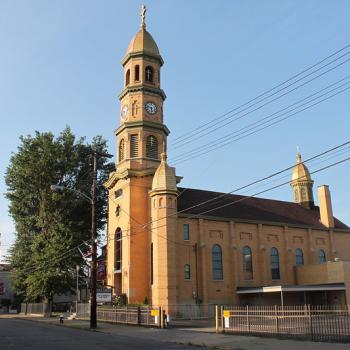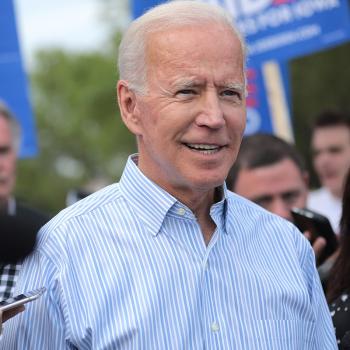
At this point, it’s become a truism that Donald Trump’s rise signals a fracturing of American political identification. Long-standing religious support for Republican candidates finally found itself in a seemingly impossible position. One could either—as many did—turn up one’s nose at an immoral candidate, not merely a liar, but a known deviant and coveter of goods. Or one could go the route of Jerry Falwell Jr. and so conflate policy positions with godliness and worthiness as to, at least in the eyes of many, forsake even the veneer of a deeper-than-the-skin piety. Many, I imagine, have found themselves in between.
Then, on the other side of the aisle, there was a lack of enthusiasm surrounding Hillary. The center-left finally found itself exhausted, and, with Bernie Sanders defeated, many either stayed home, limply threw a bone Hillary’s way, or, as in some Midwestern states, defected to Trump.
It wasn’t said much at the time, but this forecasts something itself foregrounded by the Donald’s campaign slogan: American greatness (if it ever existed) was in notable decline, perhaps on life support. This is not merely the nostalgia of the Trump voter, nor is it some recollection of the bygone days of Bush II. Even during George W.’s presidency, one could make the argument that America’s reassertion of its role as world police was, in reality, a cover-up. How did Shakespeare put it? Right: “the lady doth protest too much methinks.”
What were we covering up?
Anecdotally, I’ve spent quite a bit of time in Europe, and I ssut admit that most public services there seem superior to our own. It’s true that much of the architecture and in Germany and England reminds me of something out of a dystopian Spanish textbook, but the NHS took care of me in the UK (at no cost!); German public transit makes NJ Transit and Amtrak look like a rail-line from Ulaanbaatar to Pyongyang (I doubt such exists, but you get the idea).
But these are mere anecdotes. What do the “experts” and numbers say? The American Society of Civil Engineers gave America a D+ in 2017. We got the same grade at their last check-in—in 2013. The BBC sums up the report:
The ASCE report says US roads are “chronically underfunded and becoming more dangerous” and assesses that one in every five miles of highway is in poor condition.
More than two of every five miles of urban interstates are congested, contributing to an estimated $160bn in wasted time and fuel in 2014.
Deaths on the roads, falling for years, rose by 7% in 2015.
There are also problems with the power grid. More than 640,000 miles of high-voltage lines are at full capacity. Most US power lines were constructed in the 1950s and 1960s and are already past their life expectancy.
Public transit is also “chronically underfunded”, ASCE says, with a $90bn rehabilitation backlog.
And airports in the US serve more than two million passengers every day. But airport infrastructure and air traffic control systems are “not keeping up,” ASCE says, resulting in increased congestion.
One Time article merely takes the problem for granted, asking how to fix it, not questioning if a crisis exists. The New Yorker doesn’t sound much more sanguine:
Even more egregious than the lack of new investment is our failure to maintain existing infrastructure. You have to spend more on maintenance as infrastructure ages, but we’ve been spending slightly less than we once did. The results are easy to see. In 2013, the Federal Transit Administration estimated that there’s an eighty-six-billion-dollar backlog in deferred maintenance on the nation’s rail and bus lines. The American Society of Civil Engineers, which gives America’s over-all infrastructure a grade of D-plus, has said that we would need to spend $3.6 trillion by 2020 to bring it up to snuff.
And, lest one think this is merely a product of partisan bias, the Week has made clear that America’s infrastructure looks, well, not so great:
Throughout the election, one of the few points Donald Trump and Hillary Clinton could agree on was the country’s need for improved infrastructure — transportation systems, energy, and so on. But tradeoffs between sustainability and economic growth make it unclear how exactly to proceed. Now, researchers argue that, to create environmentally sustainable infrastructure, we need to pay attention to what’s keeping us from investing in infrastructure more broadly.
“For the world to meet the twin challenges of improving human welfare whilst preventing the worst impacts of climate change, it will need to develop and follow a model of emissions minimizing, resource-efficient ‘green’ economic growth,” Ilmi Granoff, J. Ryan Hogarth, and Alan Miller write in a Nature Climate Change perspective. Meeting those challenges may require a new approach.
“First, scaling up infrastructure investment is a necessary condition to achieving green growth, but not a sufficient condition: It can lock in emissions or efficiency,” the team writes. “Second, mobilizing capital for low-carbon infrastructure investment will have less to do with establishing billions of dollars in ‘new’ resources for low-carbon infrastructure, and more to do with unlocking and decarbonizing the trillions of dollars in annual infrastructure investment yet to be deployed under any growth scenario.”
Those conclusions stem from several observations about the state of infrastructure spending around the world. First, despite evidence of economic benefits, investment in buildings, roads, and transportation has fallen in countries like the United States and Germany in recent years, according to an International Monetary Fund report. At the same time, much of the infrastructure in those countries is starting to crumble. In developing countries, there’s simply less infrastructure to begin with.
This is, of course, just to bring up infrastructure. There’s also, for example, homelessness. Europe has seen a rise in homelessness over the last ten years or so, though the numbers are still dwarfed by those in the U.S., where, in 2014 it was estimated that 2.5 million children experienced homeless, with some reporting general numbers as high as 3.5 million.
Anecdotally, I spend a lot of time in New York City, where the homeless are at once ever visible and totally invisible; whereas, my experiences in Berlin, Oxford, Freiburg, Zurich, and Vienna have (again, at a personal level) been very different. In Germany, it’s not uncommon to see quasi-homeless punks on the streets, living with their dogs and traveling in—I kid you not—packs. To my eyes, the level of degradation among the homeless in the EU is much reduced, though my experiences need mean nothing. At minimum, one study (from 2007) had this to say:
The highest rates for lifetime literal homelessness were found in the UK (7.7%) and United States (6.2%), with the lowest rate in Germany (2.4%), and intermediate rates in Italy (4.0%) and Belgium (3.4%). Less compassionate attitudes toward the homeless were also found on many dimensions in the United States and the UK.
Add in our healthcare crisis and epidemic drug use (my high-school graduating class alone has seen four student deaths from opiates since I left) and things, to understate them, don’t look the best for the United States.
Trump’s campaign clued us into this fact, even if its reality was obscured by what exactly was meant by “great again.” The sad truth is that the Bush-era cover-up remains on the books. Only in the realm of foreign policy do we really still pretend to act as a “great nation.” This veneer, for whatever it’s worth, may finally come to end, may finally find its final symptom in, you guessed it, Donald Trump.
I did not think Donald Trump would be impeached; in a way, I still don’t. But the fact is that we’re now talking about it in earnest. Given a slew of recent gaffes, residual dissatisfaction with Trump as a man and president, and the fact that he was never all that popular to begin with, the possibility is not now entirely farfetched. Only the total inefficacy of the Democratic opposition and Republican control of both houses of Congress really stand in the way of the beginning of such proceedings.
To be clear, I think impeachment unlikely. But, were it to come, Trump would likely be the first president successfully impeached (if your own party has to turn on you to get impeachment on the table, things don’t look very good). Andrew Johnson escaped removal by one vote. Nixon resigned to avoid impeachment proceedings. Clinton, of course, handily beat efforts to get rid of him.
Trump’s demise thus would be a singular event in the history of the United States. So much talk of his removal centers around what comes next: President Pence? The future of the GOP? An effete Democratic Party? This is understandable, but it misses the real meaning of his successful impeachment; such views miss the grander-scale catastrophe afoot. If all we have left to justify ourselves in our “greatness” is stable governance, foreign authority, and a long-fought-for aura of respectability, Trump’s defeat would shake the world loose of all such illusions. We cannot claim “greatness” in any meaningful domestic sense; we cannot really claim it in terms of foreign policy, except insofar as we have waged wildly unpopular wars abroad. With Trump gone, the veneer would finally be ripped away. The United States would be unmasked for what it is: just another country, and, to be honest, not a particularly amazing one at that.
From a Catholic perspective, I wonder if this wouldn’t be a good thing. I continue to think successful impeachment unlikely; I continue to believe that the next four years will look typically Republican, if not with a bit more silliness and absurdity. But it’s hard not to wonder: if America goes down, what becomes of the jingoism and patriotism so endemic to the Religious Right? The City on the Hill would finally have to come to terms with its rotting sewage, its hordes of homeless, its rusted trains packed with the destitute. Would such actually change the minds of our Christians? Could we return to a godliness divorced from undue patriotism?
One can hope.













